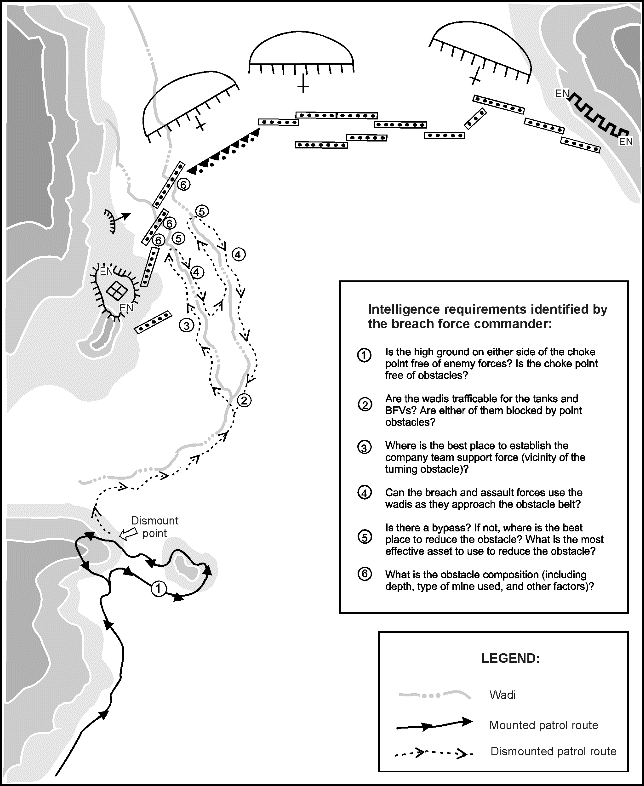 |
Other Tactical OperationsThis chapter covers tasks the company team may conduct, either on its own or as part of a larger force, to complement or support its primary missions. |
|||
SECTION 1 - RECONNAISSANCE |
|||
|
Reconnaissance is any mission undertaken, using visual observation or other methods, to obtain information regarding the activities and resources of enemy forces or the physical characteristics of a particular area. Successful reconnaissance is a focused collection effort, aimed at gathering timely, accurate information about the enemy and the terrain in the area of operations. It is the responsibility of every commander to conduct reconnaissance, with the goal of gaining the information he needs to ensure the success of his mission. In addition, the company team may conduct other reconnaissance operations to gather information for higher headquarters. For a more detailed discussion of reconnaissance operations, refer to FM 17-95 or FM 100-40. |
|||
Reconnaissance planning starts with the commanderís identification of critical information requirements. This process may be conducted while the unit is planning or preparing for an operation; in may cases, it will continue during the conduct of the operation. As an example of identifying information requirements before an operation, the company team commander determines that he must find out if an enemy force is controlling a choke point through which the team must move during the next dayís attack. As a result, the commander may decide to send an infantry patrol to reconnoiter the choke point the night before the attack. Once the operation is under way, the commander continues to identify information requirements. An example is the need to find an assailable flank or another position of advantage over an identified enemy force while the company team develops the situation; in such a situation, the commander may dispatch a platoon or section to find a flank or position from which the team can effectively engage the enemy. |
|||
Reconnaissance can be passive or active. Passive reconnaissance includes such techniques as map and photographic reconnaissance and surveillance. Active methods available to the company team include mounted and dismounted ground reconnaissance and reconnaissance by fire. Active reconnaissance operations are also classified as stealthy or aggressive, as discussed in the following paragraphs. |
|||
Stealthy |
Stealthy reconnaissance emphasizes procedures and techniques that allow the unit to avoid detection and engagement by the enemy. It is more time-consuming than aggressive reconnaissance. To be effective, stealthy reconnaissance must rely primarily on dismounted elements that make maximum use of covered and concealed terrain. The company teamís primary assets for stealthy reconnaissance are its infantry squads. For a more detailed discussion of dismounted patrolling, refer to FM 7-10 or FM 17-98. |
||
Aggressive |
Aggressive reconnaissance is characterized by the speed and manner in which the reconnaissance element develops the situation once contact is made with an enemy force. A unit conducting aggressive reconnaissance uses both direct and indirect fires and movement to rapidly develop the situation. It uses primarily mounted reconnaissance and reconnaissance by fire. In conducting a mounted patrol, the unit employs the principles of tactical movement to maintain security. The patrolling element maximizes the use of cover and concealment and conducts bounding overwatch as necessary to avoid detection. For a more detailed discussion of tactical movement, refer to Chapter 3 of this manual. The discussion of direct fire control in Chapter 2 includes a description of reconnaissance by fire. |
||
To be most effective, reconnaissance must be continuous, conducted before, during, and after operations. Before an operation, the company team focuses its reconnaissance effort on filling gaps in its information about the enemy and terrain. (NOTE: Figure 5-1 shows an example of company team reconnaissance prior to an operation.) After an operation, the team normally conducts reconnaissance to maintain contact with the enemy and collect information for upcoming operations. Situations in which the company team may conduct reconnaissance before or after an operation include the following:
|
|||
|
During offensive operations, company team reconnaissance normally focuses on fighting for information about the enemy and the terrain, with the primary goal of gaining an advantage over the enemy. The company team conducts this type of reconnaissance during actions on contact. As the team develops the situation, the commander may dispatch mounted or dismounted patrols to identify positions of advantage or to acquire an enemy force. The information gained by the company team while in contact is critical not only to the success of its own mission but also to the success of its higher headquarters. Actions on contact are discussed in detail in Chapter 3 of this manual. |
|||
 |
Figure 5-1. Example of a company team commander identifying intelligence requirements
and using patrols to conduct reconnaissance.
In addition to reconnaissance performed as part of another type of operation, there are four forms of reconnaissance that are conducted as distinct operations: route reconnaissance, zone reconnaissance, area reconnaissance, and reconnaissance in force. Although not optimally organized for reconnaissance, the company team can conduct route, zone, or area reconnaissance. It may conduct a reconnaissance operation during preparation for another operation of its own (for example, performing zone reconnaissance before initiating a stationary guard operation), or it can conduct the reconnaissance to gain information for a higher headquarters. The team will normally be task organized with additional combat or CS assets as needed to meet the requirements of the reconnaissance operation. (NOTE: Reconnaissance in force is a limited-objective operation conducted by battalion-size and larger forces.) |
|||
Positioning of |
In conducting a route, zone, or area reconnaissance, the company team employs a combination of mounted and dismounted elements as well as reconnaissance by direct and indirect fires. Based on his evaluation of METT-TC factors, the team commander establishes the role of organic elements and support assets within his scheme of maneuver. The following considerations apply:
|
||
Focus of the |
In planning for route, zone, or area reconnaissance, the company team commander must determine the focus of the mission, identifying whether the reconnaissance will be oriented on the terrain or on the enemy force. It is then essential that he provide the team with clear guidance on the focus of the reconnaissance. In a force-oriented reconnaissance operation, the critical task will simply be to find the enemy and gather information on him; terrain considerations of the route, zone, or area are only a secondary concern. The company team generally is able to move more quickly than in terrain-oriented reconnaissance. |
||
Conduct of the |
The following paragraphs examine the specifics of route, zone, and area reconnaissance. For a more detailed discussion of these operations at the company/troop level, refer to FM 17-97. |
||
Route |
A route reconnaissance is a directed effort to obtain detailed information on a specific route as well as on all terrain from which the enemy could influence movement along that route. Route reconnaissance may be oriented on a specific area of movement, such as a road or trail, or on a more general area, like an axis of advance. It is normally assigned when a commander wants to use the route in question. Although METT-TC and the commanderís intent will ultimately dictate what actions the company team must take, the following tasks are normally considered critical components of the route reconnaissance:
|
||
| Zone reconnaissance |
A zone reconnaissance is a directed effort to obtain detailed information concerning all routes, terrain, enemy forces, and obstacles (including areas of chemical and radiological contamination) within a zone, which is defined by specific boundaries. The zone reconnaissance is normally conducted when the enemy situation is vague or when information concerning cross-country trafficability is required. As in route reconnaissance, METT-TC and the commanderís intent will dictate the company teamís actions during a zone reconnaissance; the following tasks are normally considered critical components of the operation:
Time permitting, the commander may also direct the company team to accomplish the following tasks as part of a zone reconnaissance:
|
||
| Area reconnaissance |
Area reconnaissance, a specialized form of zone reconnaissance, is a directed effort to obtain detailed information concerning the terrain or enemy activity within a prescribed area. The area can be any location that is critical to the unitís operations. Examples include easily identifiable areas covering a fairly large space (such as towns or military installations), terrain features (ridge lines, wood lines, choke points), or a single point (like a bridge or a building). The critical tasks of the area reconnaissance are the same as those associated with zone reconnaissance. |
||
SECTION 2 - SECURITY OPERATIONS |
|||
|
Security operations are conducted to provide early and accurate warning of enemy operations, to provide the protected force with time and maneuver space to react to the enemy, and to develop the situation to allow the commander to effectively employ the protected force. These operations may be conducted to the front, flanks, or rear of the force. For additional information on security operations, refer to FM 17-95 or FM 100-40. The four forms of security operations are screen, guard, cover, and area security. The screen, guard, and cover entail deployment of progressively higher levels of combat power and provide increasing levels of security for the main body. Area security preserves a higher commanderís freedom to move his reserves, position fire support assets, conduct command and control operations, and provide for sustainment operations. NOTE: All forces have an inherent responsibility to provide for their own local security. Local security includes OPs, local security patrols, perimeter security, and other measures taken to provide close-in security for the force. Refer to the discussion at the end of this section. The company team can conduct screen or guard operations on its own. It participates in area security missions and covering force operations only as part of a larger element. The company team always provides its own local security. (NOTE: As part of a larger elementís area security operation, the company team may conduct route clearance or convoy escort operations; refer to Appendix J for a detailed discussion on these missions.) |
|||
Security operations require the commander assigning the security mission and the security force commander to address a variety of special operational factors. These planning considerations are discussed in the following paragraphs. |
|||
Augmentation of |
When it is assigned to conduct a guard or screen mission, the company team may receive additional combat, CS, and CSS elements. Attachments may include, but are not limited to, the following:
|
||
Enemy-related |
Security operations require the company team to deal with a unique set of enemy considerations. For example, the array of enemy forces (and the tactics that enemy commanders use to employ them) may be different from those for any other tactical operation the team will conduct. Additional enemy considerations that may influence company team security operations include, but are not limited to, the following:
- Insurgent elements (not necessarily part of the enemy force). - Enemy reconnaissance elements of varying strength and capabilities (at divisional, regimental, or other levels). - Enemy security elements (such as CRPs or forward patrols). - Enemy stay-behind elements or enemy elements that have been bypassed. - Reconnaissance and/or infiltration routes. - OP sites for surveillance and/or indirect fire observers. - Surveillance devices, such as radar devices or UAVs. - Long-range rocket and artillery assets. - Helicopter and fixed-wing air strikes. - Elements capable of dismounted insertion and/or infiltration. - Mechanized forward detachments. |
||
Time the security |
The time by which the screen or guard must be set and active will influence the company teamís method of deploying to the security area as well as the time it begins the deployment. |
||
Reconnaissance of |
The company team commander uses a thorough analysis of METT-TC factors to determine the appropriate methods and techniques the company team will use in accomplishing this critical action. (NOTE: The commander must make every effort to conduct his own reconnaissance of the security area he expects the team to occupy, even when the operation is preceded by a zone reconnaissance by other task force elements.) |
||
Movement to the |
In deploying elements to an area for a stationary security mission, the company team commander must deal with the competing requirements of establishing the security operation quickly to meet mission requirements and of providing the necessary level of local security in doing so. The team can move to the security area using one of two basic methods: a tactical road march or a movement to contact. Either method should be preceded by a zone reconnaissance by the task force scout platoon. The following paragraphs examine considerations and procedures for the two methods of movement. |
||
Tactical road march |
The company team conducts a tactical road march to an RP behind the security area. From that point, the platoons (or sections) deploy to occupy their initial positions. This method of deployment is faster than a movement to contact, but less secure. It is appropriate when enemy contact is not expected or when time is critical. |
||
Movement to contact |
The company team conducts a movement to contact from the LD to the security area. This method is slower than a tactical road march, but it is more secure. It is appropriate when time is not critical and either enemy contact is likely or the situation is unclear. |
||
Location and |
The main body commander determines the location, orientation, and depth of the security area in which he wants the security force to operate. The security force commander conducts a detailed analysis of the terrain in the security area. He then establishes his initial dispositions (usually a screen line, even for a guard mission) as far forward as possible on terrain that allows clear observation of avenues of approach into sector. The initial screen line is depicted as a phase line and sometimes represents the FLOT. As such, the screen line may be a restrictive control measure for movement; this requires the company team commander to conduct all necessary coordination if he decides to establish OPs or to perform reconnaissance forward of the line. |
||
Initial OP locations |
The company team commander may deploy OPs to ensure effective surveillance of the sector and designated NAIs. He will designate initial OP locations on or behind the screen line. He should provide OP personnel with specific orientation and observation guidance, including, at a minimum, the primary orientation for the surveillance effort during the conduct of the screen. Once set on the screen line, the surveillance elements (normally, either scouts or mechanized infantrymen) will report their location. The element that occupies each OP always retains the responsibility for changing the location in accordance with tactical requirements and the commanderís intent and guidance for orientation. OPs may be either mounted or dismounted. Mounted OPs allow use of vehicular optics and weapon systems and maximize speed of displacement, but are more easily detected by the enemy. Dismounted OPs maximize stealth. |
||
Width and depth |
The company team sector is defined by lateral boundaries extending out to an LOA (the initial screen line) forward of a rear boundary. The teamís ability to maintain depth through the sector decreases as the screened or guarded frontage increases. |
||
Special requirements
| The company team commander must specify any additional considerations for the security operation, including, but not limited to, the following:
|
||
Indirect fire planning |
The company team commander conducts indirect fire planning to integrate artillery and mortar assets into the security mission. A wide sector may require him to position attached mortar assets where they can provide effective coverage of the enemyís most likely axis of attack or infiltration route, as determined in his analysis of the enemy. The commander can position the mortars so that up to two-thirds of their maximum range lies forward of the initial screen line. The company team FIST assists the commander in planning artillery fires to adequately cover any gaps in mortar coverage. |
||
Positioning of |
The commander normally positions himself where he can observe the most dangerous enemy axis of attack or infiltration route, with the XO positioned on the second most critical axis or route. The XO positions the team CP (if used) in depth and, normally, centered in sector; this allows the CP to provide control of initial movement, to receive reports from the screen or guard elements, and to assist the commander in more effectively facilitating command and control. Combat trains are positioned behind masking terrain, but they remain close enough for rapid response. The trains are best sited along routes that afford good mobility laterally and in depth. |
||
Patrols may be required to cover gaps between the OPs. The company team commander will task elements to conduct either mounted or dismounted patrols as required. |
|||
Coordination |
The company team commander must conduct adjacent unit coordination to ensure there are no gaps in the screen or guard and to ensure smooth execution of the teamís rearward passages of lines (if required). Additionally, he must coordinate the teamís follow-on mission. |
||
CSS considerations |
The company team commanderís primary consideration for CSS during the security operation is coordinating and conducting resupply of the team, especially for Class III and Class V supplies. (NOTE: One technique is for the commander to position prestock Class III and Class V vehicles at the teamís successive positions.) In addition to normal considerations, however, the commander may acquire other responsibilities in this area, such as arranging CSS for a large number of attached elements or coordinating resupply for a subsequent mission. The company teamís support planning can be further complicated by a variety of factors. These include the extended distances from the task force combat trains and the BSA over which the team must operate (making resupply, casualty evacuation, and vehicle recovery more difficult), the wide frontages that the team must cover, and the increased numbers of attachments for which the team must provide resupply and other support services (such as casualty evacuation). To prevent these factors from creating outright tactical problems, the company team must receive logistical support, such as additional medical evacuation vehicles, from the controlling task force. |
||
Follow-on missions |
The complexities of security missions, combined with normal operational requirements (such as troop-leading procedures, engagement area development, rest plans, and CSS activities), can easily rob the company team commander of the time he needs for planning and preparation of follow-on missions. He must address these competing demands in his initial mission analysis to ensure that the team, and its leaders, can adequately meet all requirements for current and future operations. If METT-TC factors permit, for example, the commander can shift his focus to preparing for follow-on missions once preparations for the security mission are complete (or satisfactorily under way). Another technique is to detach the XO, with support personnel and vehicles, to prepare for follow-on missions. The XOís party can handle such operational requirements as reconnaissance, coordination, and development of follow-on engagement areas and BPs. |
||
A screen primarily provides early warning. It observes, identifies, and reports enemy actions. A screen provides the least amount of protection of any security mission. Generally, a screening force engages and destroys enemy reconnaissance elements within its capabilities, but otherwise fights only in self-defense. It normally does not have the combat power to develop the situation. |
|||
Purposes |
A screen is appropriate to cover gaps between forces, the exposed flanks or rear of stationary and moving forces, or the front of a stationary formation; it is used when the likelihood of enemy contact is remote, the expected enemy force is small, or the friendly main body needs only a minimum amount of time once it is warned to react effectively. Screening is largely accomplished by establishing a series of OPs and conducting patrols to ensure adequate surveillance of the assigned sector. Purposes of the operation include the following:
|
||
Stationary screen |
The company team commander first takes a close look at infiltration routes into the screen sector, then assigns surveillance responsibility to the teamís subordinate elements. He designates locations of OPs, which should be in depth through the sector. The OPs are normally manned by sections within the company team. The commander identifies the enemyís likely axes of attack or infiltration routes; if necessary, he identifies additional control measures (such as NAIs, phase lines, TRPs, or checkpoints) to assist in movement control and in tracking of enemy elements. The company team conducts mounted and dismounted patrols to reconnoiter areas that cannot be observed from OPs. Once the enemy is detected from an OP, the screening force normally engages him with indirect fires. This prevents the enemy from penetrating the screen line and does not compromise the location of the OP. Within its capability, the screening force may destroy enemy reconnaissance assets with direct fires if indirect fires cannot accomplish the task. (NOTE: For additional details, refer to the discussion of actions against enemy reconnaissance elements in the guard segment of this section). The screening force also impedes and harasses other enemy elements, primarily through the use of indirect fires. If enemy pressure threatens the security of the screening force, the unit normally reports the situation and requests permission to displace to a subsequent screen line. |
||
Moving screen |
The company team can conduct a moving screen to the flanks or rear of the screened force. The movement of the screen is keyed to time and distance factors associated with the movement of the friendly main body. |
||
Moving flank screen |
Responsibilities for a moving flank screen begin at the front of the main bodyís lead combat element and end at the rear of the protected force. In conducting a moving flank screen, the company team either occupies a series of temporary OPs along a designated screen line or, if the protected force is moving too fast, continues to move while maintaining surveillance and preparing to occupy a designated screen line. There are four basic methods of controlling movement along the screened flank. The screening force may use one or more of these methods as the speed of movement of the protected force changes or contact is made. The four methods are described in the following paragraphs. Alternate bounds by individual OP. This method is used when the protected force is advancing slowly or enemy contact is likely along the screen line. Designated elements of the screening force move to and occupy new OPs as dictated by the enemy situation and the movement of the main body. Other elements remain stationary, providing overwatch and surveillance, until the moving elements establish their new positions; these elements then move to new positions while the now-stationary elements provide overwatch and surveillance. This sequence continues as needed. The method of alternate bounding by individual OP is secure but slow. Alternate bounds by unit. This method is used when the protected force is advancing slowly or enemy contact is likely along the screen line. Designated elements of the screening force move and occupy new positions as dictated by the enemy situation and the movement of the main body. Other elements remain stationary, providing overwatch and surveillance, until the moving elements establish their new positions; these elements then move to new positions while the now-stationary elements provide overwatch and surveillance. This sequence continues as needed. The method of alternate bounding by unit is secure but slow. Successive bounds. The screening element uses this method when enemy contact is possible and the main body makes frequent short halts during movement. Each platoon of the screening force occupies a designated portion of the screen line each time the main body stops. When main body movement resumes, the platoons move simultaneously, retaining their relative position as they move forward. Continuous marching. This method is used when the main body is advancing rapidly at a constant rate and enemy contact is not likely. The screening force maintains the same rate of movement as the main body, at the same time conducting surveillance as necessary. Stationary screen lines are planned along the movement route, but the screening force occupies them only as necessary to respond to enemy action. |
||
Moving rear screen |
A moving rear screen may be established to the rear of a main body force conducting an offensive operation or between the enemy and the rear of a force conducting a retrograde operation. In either case, movement of the screen is keyed to the movement of the main body or to the requirements of the enemy situation; the operation is normally controlled by movement to a series of phase lines. |
||
A guard force protects the friendly main body either by fighting to gain time (while simultaneously observing the enemy and reporting pertinent information) or by attacking, defending, and/or delaying the enemy to prevent him from observing the main body and engaging it with direct fires. There are three types of guard operations (advance guard, flank guard, and rear guard). They can be conducted in support of either a stationary or a moving friendly force. The guard force differs from a screening force in that it contains sufficient combat power to defeat, repel, or fix the lead elements of an enemy ground force before they can engage the main body with direct fires. In addition, the guard force normally deploys over a narrower front than does a comparably sized screening force, allowing greater concentration of combat power. The guard force routinely engages enemy forces with both direct and indirect fires (it normally operates within range of the main bodyís indirect fire weapons). |
|||
Purposes |
The purposes of the guard operation, in addition to those listed in the earlier discussion of the screen, include the following:
|
||
Types of guard |
The following discussion covers operational considerations for advance guard, flank guard, and rear guard operations. |
||
Advance guard |
An advance guard for a stationary force is defensive in nature. The company team defends or delays in accordance with the intent of the main body commander. An advance guard for a moving force is offensive in nature. The company team normally conducts an offensive advance guard mission during a movement to contact as part of a task force. Its role is to maintain the freedom of maneuver of the supported task force; it does this by providing early warning of enemy activity to the protected task force and by finding, fixing, and destroying enemy reconnaissance and security elements. For more details on advance guard operations, refer to the discussion of movement to contact in Chapter 3 of this manual. |
||
Flank guard |
A flank guard protects an exposed flank of the main body. A flank guard is similar to a flank screen except that both OPs and defensive positions are planned. The company team may conduct a moving flank guard during an attack or a movement to contact. In conducting a moving flank guard, the company team will normally occupy a series of BPs along the protected flank. It must maintain orientation both to the front (to perform its overwatch role and to maintain its own security) and to the protected flank. It must also maintain a sufficient distance from the main body to prevent the enemy from engaging the main body with long-range direct fires before early warning can be sent. A more detailed discussion later in this section focuses on execution of a moving flank guard. |
||
Rear guard |
The rear guard protects the rear of the main body as well as all CS and CSS elements within the main body. This may occur during offensive operations when the main body breaks contact with the FLOT or during retrograde operations. A rear guard may be deployed behind both moving and stationary main bodies. The rear guard for a moving force displaces to successive BPs along phase lines or delay lines in depth as the main body moves. During retrograde operations, the rear guard normally deploys its elements across the entire sector behind the main bodyís forward maneuver units. For a more detailed discussion of retrograde operations, refer to Section 6 of Chapter 4. |
||
Stationary guard |
As noted, a stationary guard mission is, at least initially, defensive in nature. The guard force normally employs OPs to accomplish all surveillance requirements of the guard mission. The company team must be prepared to conduct actions against the enemyís main body and security elements as well as his reconnaissance forces. The following paragraphs discuss considerations for operations involving these enemy elements. |
||
| Actions against main body and security elements |
Once contact is made with an enemy main body or security force, the guard force attacks, defends, or delays in accordance with the enemy situation and the intent of the commander of the protected force. (NOTE: Considerations for the defense are discussed in Chapter 4 of this manual; considerations for retrograde operations are covered in Section 6 of Chapter 4.) |
||
| Actions against reconnaissance elements |
When it must execute counterreconnaissance tasks, the team will normally task organize into a surveillance element (normally occupying a screen line) and an attack element. Each element has specific responsibilities but must be prepared to work effectively with the other to ensure success of the operation. Surveillance element and surveillance sectors. The commander must assign clear responsibilities for surveillance of identified avenues of approach and designated NAIs. The surveillance element (normally scout or mechanized infantry elements) is tasked with detecting, reporting, and maintaining contact with the enemy in the assigned surveillance sector. In addition, the surveillance element is responsible for passing off the enemy force to the attack element for destruction. Attack element. In this role, the company teamís tank platoons (or sections) will be the primary direct fire killing assets and will remain responsive to the commander. (NOTE: Depending on the composition of the company team conducting the guard mission, BFVs may also be employed in this role, especially in a mech-heavy team.) The attack element occupies hide positions, BPs, or attack by fire positions along enemy avenues of approach. Once alerted by the surveillance force, it moves into position (if necessary) and destroys the approaching enemy element. The attack element is responsible for direct fire planning and engagement area development in support of the commanderís plan. It must also rehearse all necessary movement to the planned fighting positions and report the required movement times to the commander. Relationship of surveillance and attack elements. The company teamís surveillance element must track locations of any enemy vehicles moving through the sector while the attack element moves into position. Once the attack element is set and can observe the enemy, the surveillance element completes target handover. This operation requires continuous communication between the two subordinate elements conducting the handover as well as close control by the company team commander or XO. In close terrain, the surveillance and attack elements must be positioned much closer together than in open terrain. This helps the elements both in maintaining visual contact and in achieving target handover at the appropriate time. Figure 5-2 illustrates a company team stationary guard operation. |
||
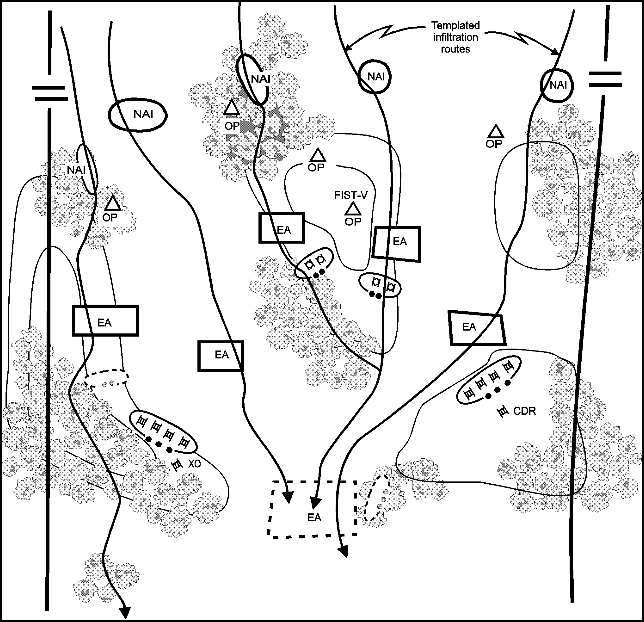 |
Figure 5-2. Example company team stationary guard (with infantry squads forward in OPs).
Moving flank guard |
Many of the considerations for a moving flank screen apply to the execution of a moving flank guard. Unlike a moving flank screen, which occupies a series of OPs, the flank guard force plans to occupy a series of defensive positions. In conducting a moving flank guard, the company team either occupies a series of temporary BPs along the protected flank or, if the protected force is moving too quickly, continues to move along the protected flank. During movement, the team maintains surveillance to the protected flank while preparing to occupy designated BPs based on enemy activity or on the movement of the protected force. There are three basic methods of controlling movement along the guarded flank:
NOTE: These are identical to the methods for controlling movement along a screened flank except that the company team and its platoons occupy designated defensive positions instead of OPs. Refer to the discussion of screen operations earlier in this section. The lead element of a moving flank guard must accomplish three tasks. It must maintain contact with the protected force, reconnoiter the flank guardís route of advance, and reconnoiter the zone between the protected force and the flank guardís advance. The rest of the flank guard marches along the route of advance and occupies BPs to the protected flank as necessary. Figure 5-3 illustrates a company team flank guard operation during a movement to contact. One platoon is employed to provide security to the front and maintain contact with the main body; the other two platoons are oriented to the protected flank. The illustration shows BPs the platoons may occupy to respond to the approaching enemy force. |
||
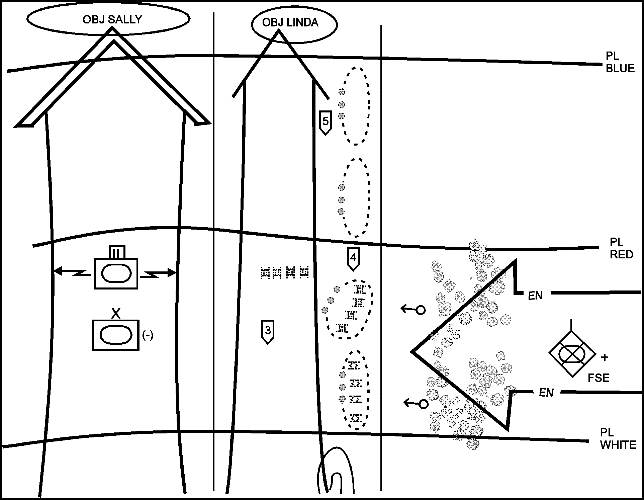 |
Figure 5-3. Example of a company team guarding the brigade flank during movement to contact.
|
The company team is responsible for maintaining its own security at all times. It does this by deploying mounted and dismounted OPs and patrols to maintain surveillance and by employing appropriate OPSEC measures. (NOTE: For a detailed discussion of OPSEC measures, refer to Appendix M of this manual.) In addition to maintaining security for its own elements, the company team may implement local security for other units as directed by the task force commander. Examples of such situations include, but are not limited to, the following:
|
|||
SECTION 3 - LINKUP |
|||
Linkup is an operation entailing the meeting of friendly ground forces (or their leaders or designated representatives). It may occur in, but is not limited to, the following situations:
|
|||
The company team conducts linkup activities independently or as part of a larger force. Within a larger unit, the team may lead the linkup force. The linkup consists of three phases; the actions outlined in the following paragraphs are critical to the execution of a successful operation: |
|||
Phase 1 - far |
During this phase, the units or elements involved in the linkup should establish communications before they reach direct fire range. The lead element of each linkup force should monitor the radio frequency of the other friendly force. | ||
Phase 2 - |
Before initiating movement to the linkup point, the forces must coordinate necessary tactical information, including the following:
|
||
Phase 3 - movement |
All units or elements involved in the linkup must enforce strict fire control measures to help prevent fratricide; linkup points and RFLs must be easily recognizable by moving and/or converging forces. Linkup elements take these actions:
|
||
SECTION 4 - PASSAGE OF LINES |
|||
A passage of lines entails movement of one or more units through another unit. This operation becomes necessary when the moving unit(s) cannot bypass the stationary unit and must pass through it. The primary purpose of the passage is to maintain the momentum of the moving elements. A passage of lines may be designated as either forward or rearward (refer to the discussion and illustrations later in this section). The controlling task force is responsible for planning and coordination of a passage of lines involving the company team. In some situations, as when the company team is using multiple passage routes (such as a separate route for each platoon), the team commander must take responsibility for planning and coordinating each phase of the operation. |
|||
In planning the passage of lines, the commander must consider the tactical factors and procedures covered in the following paragraphs. |
|||
Passage lanes |
The passage should facilitate transition to follow-on missions through the use of multiple lanes or of lanes wide enough to support doctrinal formations for the passing units. |
||
Use of deception |
Deception techniques, such as the use of smoke, may be employed to enhance security during the passage. |
||
Battle handover |
The controlling commander must clearly define the battle handover criteria and procedures to be used during the passage. His order should cover the roles of both the passing unit and the stationary unit and the use of direct and indirect fires. If necessary, he also specifies the location of the BHL as part of the unitís graphic control measures. For a forward passage, the BHL is normally the LD for the passing force; in a rearward passage, it is normally a location within the direct fire range of the stationary force. In general, a defensive handover is complete when the passing unit is clear and the stationary unit is ready to engage the enemy. Offensive handover is complete when the passing unit has deployed and crossed the BHL. |
||
Obstacles |
The passing and stationary units must coordinate obstacle information, to include the locations of enemy and friendly obstacles, of existing lanes and/or bypasses, and of guides for the passage. |
||
Air defense |
Air defense coverage is imperative during the high-risk passage operation. Normally, the stationary unit will be responsible for providing air defense, allowing the passing unitís air defense assets to move with it. |
||
CSS responsibilities |
Responsibility for CSS actions, such as vehicle recovery or casualty evacuation in the passage lane, must be clearly defined for both passing and stationary units. |
||
Command and control |
To enhance command and control during the passage, the company team will collocate a command and control element, normally the commander or XO (and his vehicle), with a similar element from the stationary or moving unit (as applicable). |
||
Detailed reconnaissance and coordination are critical in a passage of lines, both in dealing with the often complex planning factors outlined previously and in ensuring that the passage is conducted quickly and smoothly. The company team commander normally conducts all necessary reconnaissance and coordination for the passage. At times, he may designate the XO, 1SG, or a platoon leader to conduct liaison duties for reconnaissance and coordination. The following items of information are coordinated (an asterisk indicates items that should be confirmed by reconnaissance):
|
|||
In a forward passage, the passing unit first moves to an assembly area or an attack position behind the stationary unit. Designated liaison personnel move forward to link up with guides and confirm coordination information with the stationary unit. Guides then lead the passing elements through the passage lane. The company team conducts a forward passage by employing tactical movement. It moves quickly, using appropriate dispersal and formations whenever possible and keeping radio traffic to a minimum. It bypasses disabled vehicles as necessary. The team holds its fire until it passes the BHL or designated fire control measure unless the commander has coordinated fire control with the stationary unit. Once clear of passage lane restrictions, the unit consolidates at a rally point or attack position and then conducts tactical movement in accordance with its orders. Figure 5-4 illustrates a forward passage of lines. |
|||
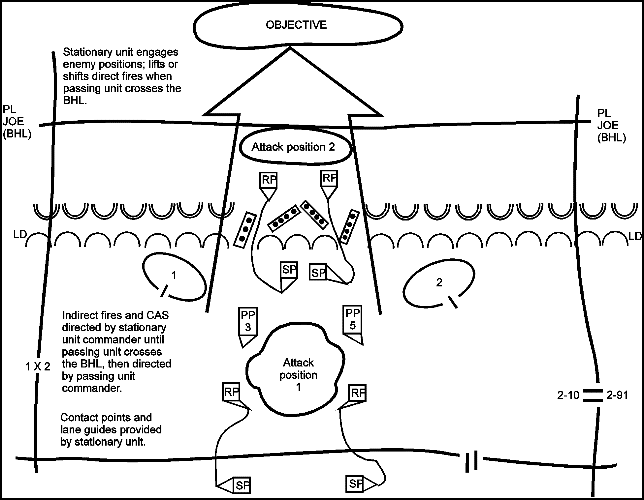 |
Figure 5-4. Company team forward passage of lines.
Because of the increased chance of fratricide during a rearward passage, coordination of recognition signals and direct fire restrictions is critical. The passing unit contacts the stationary unit while it is still beyond direct fire range and conducts coordination as discussed previously. Near recognition signals and location of the BHL are emphasized. Additional fire control measures, such as RFLs, may be employed to further minimize the risk of fratricide. Following coordination, the passing unit continues tactical movement toward the passage lane. Gun tubes are oriented on the enemy, and the passing unit is responsible for its own security until it passes the BHL. If guides are provided by the stationary unit, the passing unit may conduct a short halt to link up and coordinate with them. The passing unit moves quickly through the passage lane to a designated location behind the stationary unit. Refer to Figure 5-5 for an illustration of the rearward passage. |
|||
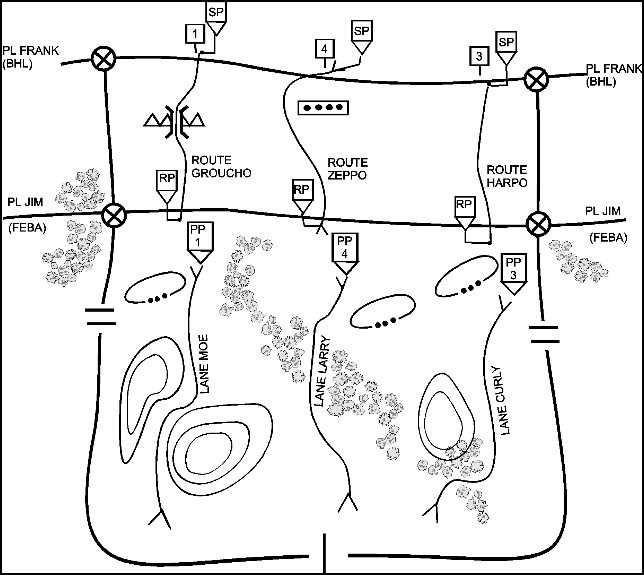 |
Figure 5-5. Company team rearward passage of lines.
SECTION 5 - RELIEF IN PLACE |
|||
A relief in place occurs when one unit is replaced by another unit during either offensive or defensive operations. Its purpose is to preserve the combat effectiveness of committed units. In a relief involving the company team, the task force commander will direct when and how the operation will be conducted. |
|||
In planning for a relief in place, the company team commander takes the following actions:
|
|||
The incoming and outgoing commanders must meet to exchange tactical information, conduct a joint reconnaissance of the area, and complete other required coordination for the relief. The two commanders must carefully address passage of command and jointly develop contingency actions to deal with enemy contact during the relief. This process will normally include coordination of the following additional information:
|
|||
During conduct of the relief, the outgoing commander retains responsibility for the area of operations and the mission. He exercises operational control over all subordinate elements of the incoming unit that have competed their portion of the relief. Responsibility can pass to the incoming commander when all elements of the outgoing unit are relieved and adequate communications are established. There are two overall methods of relief, sequential and simultaneous, with elements relieved one at a time or all at once. In addition, the relief of individual elements can be conducted in one of two ways:
|
|||
Sequential relief |
This is the most time-consuming method. The relieving unit moves to an assembly area to the rear of the unit to be relieved. Subordinate elements are relieved one at a time. This can occur in any order, with the relief generally following this sequence:
|
||
Simultaneous relief |
This is the fastest, but least secure, method. All outgoing elements are relieved at once, with the incoming unit normally occupying existing positions, including BPs and vehicle and individual fighting positions. The relief takes place in this general sequence:
|
||
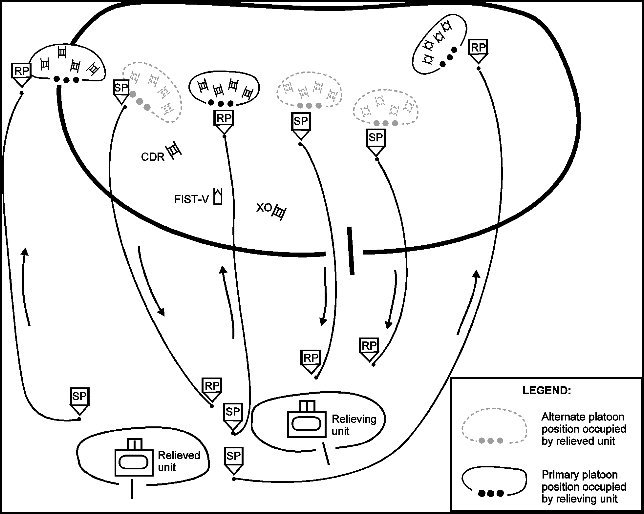 |
Figure 5-6. Example relief in place by alternate platoon positions.
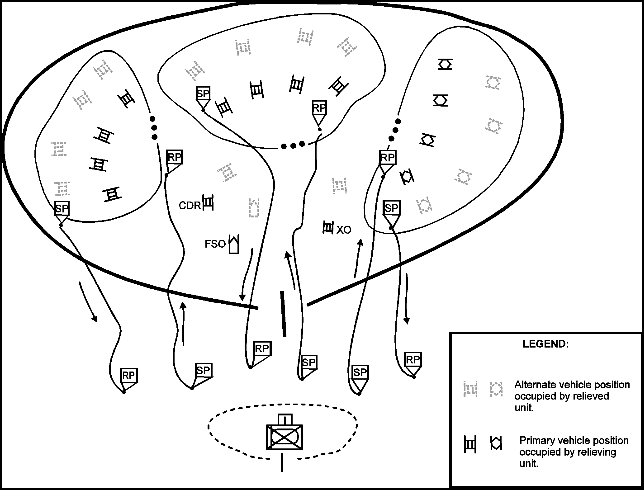 |
Figure 5-7. Example relief in place by alternate vehicle positions.
SECTION 6 - BREACHING OPERATIONS |
|||
Obstacle breaching is a high-frequency task during offensive operations. Breaching entails the employment of a combination of TTP and equipment to project combat power to the far side of an obstacle. The company team commander must understand the challenges presented by various types of obstacles and the capabilities and limitations of the mobility assets the team can employ to defeat them. He must further understand the basic tenets of breaching operations and the types of breaches the company team may be tasked to conduct. FM 90-13-1 contains a more detailed discussion of breaching operations and threat obstacle employment. |
|||
The following paragraphs summarize the capabilities and limitations of the breaching assets available to the company team. |
|||
Mine plow |
Also known as the mine-clearing blade, the mine plow is used to breach and proof minefields. The system affords good survivability. When fully operational, a tank equipped with a mine plow can quickly clear two 68-inch-wide lanes, one in front of each track. (NOTE: The plowís dogbone assembly will detonate the tilt rods of mines in the area between the two plowed lanes; however, only plows equipped with the improved dogbone assembly, known as the IDA, will defeat magnetically activated mines.) The plow must be dropped at least 100 meters before the tank reaches the minefield. It then is not lifted until the tank is at least 100 meters past the far edge of the minefield. The plow must have 18 inches of spoil to be effective, limiting the tankís speed to 10 mph or less in the lane. The mine plow should be used only in a straight line; it does not work well on hard, rocky, or uneven ground where it cannot maintain adequate spoil. Mine detonation can cause violent upward movement of the blade; the tankís main gun must be traversed to the side during plowing to prevent damage to the gun tube. The plowís lifting straps can become entangled in wire obstacles. Manual lifting of the plow takes at least 10 minutes. |
||
Mine roller |
The mine roller is used to identify the forward edges of a minefield and to proof lanes. The roller sweeps a 44-inch path in front of each track and is also equipped with a dogbone assembly. It is also effective at breaching wire obstacles. The roller, however, is not effective on broken or uneven ground. The mine roller, like the mine plow, will not defeat magnetically fuzed mines unless equipped with the IDA. The main gun must be traversed to the side or rear when contact with a mine is possible or imminent; detonation can throw the roller (or pieces of it) violently upward, possibly damaging the tube. |
||
Mine-clearing |
Used to breach wire and mine obstacles, the MICLIC can be either towed or mounted on an M60A1 chassis (this vehicle is known as the AVLM). It clears a lane 100 meters deep and 14 meters wide. (NOTE: The MICLIC must be fired 62 meters from the obstacle to get the full 100 meters of depth.) The charge may create two skip zones, where the mines are not detonated, on the right and left side of the center line of the cleared lane. The skip zones, which are about 1.5 meters wide, require all MICLIC lanes to be proofed. The MICLIC is effective against pressure-activated antitank mines and against mechanically activated antipersonnel mines. Effectiveness is limited against magnetically activated mines, including scatterable mines, and those with multiimpulse (double-impact) or time-delay fuzes. The MICLIC is not effective on severely broken ground where the line charge cannot lay flat. When detonated, the MICLIC has danger area with a radius of 1,600 meters. |
||
Armored combat |
Using its blade, the ACE can defeat berms and antitank ditches. The ACE can also skim a minefield with its blade; however, it is slow and vulnerable in this role and should be employed this way only as a last resort. The vehicle is further limited by its one-man crew. |
||
Armored vehicle |
The AVLB is primarily employed to cross short gaps, such as narrow streams, antitank ditches, craters, canals, or partially blown bridges. Its span is 18 meters (60 feet) using prepared abutments and 17 meters with unprepared abutments. The capacity of the bridge is one military load class (MLC) 60 vehicle (this is waived for M1-series tanks in combat operations). The AVLB launcher, which requires 10 meters of overhead clearance for transportation and operation, is most visible and vulnerable during launching of the bridge. An experienced crew can launch the bridge in two to five minutes. NOTE: The AVLB will soon be replaced by the Wolverine, which is based on an M1-series chassis. The new bridge will be able to support MLC 70 vehicles across a gap of up to 24 meters. |
||
Engineer squad |
The most versatile of all breaching assets, the engineer squad can conduct explosive or manual breaches and proofing and can mark lanes through an obstacle. While it is conducting these breaching and proofing operations, however, the squad is extremely vulnerable to enemy direct and indirect fires. |
||
Mechanized infantry |
If other breaching assets are unavailable, a mechanized infantry or tank platoon can conduct explosive breaches (with hand-emplaced charges) and/or use manual breaching kits (normally consisting of grappling hooks, gloves, and wire cutters). At the same time, however, employment of either type of platoon organization in breaching operations has distinct disadvantages. The pace of the breach will be slow, and the operation will leave the platoon vulnerable to enemy attack. For a more detailed discussion of manual breaching techniques for the mechanized infantry platoon, refer to FM 7-7J. |
||
In the planning and execution of a successful combined arms breaching operation, the company team commander must apply the five tenets of breaching. These basic principles, described in this discussion, are the following:
|
|||
Intelligence |
Well-rehearsed drills and SOPs and redundancy in breaching assets can offset a lack of obstacle intelligence (OBSTINTEL) in breaching operations involving simple obstacles or lightly defended obstacles. Detailed OBSTINTEL, however, is imperative for a successful breach of a complex obstacle. Without thorough information on the obstacle itself and the defense it supports, the breach force will be at risk. At a minimum, OBSTINTEL requirements for breach and maneuver planning should cover the following:
- Type of mines employed, by target type (antipersonnel, antitank), positioning (buried, surface-laid), and/or method of activation (pressure, mechanical, magnetic). - Presence of antihandling devices. - Size of the obstacle and whether it is tied into existing or reinforcing obstacles. |
||
Breaching |
These summarize the four basic steps that are part of every breaching operation. The simplified steps, known by the abbreviation SOSR, are these:
|
||
Breaching |
The breach commander designates support, breach, and assault forces. The following paragraphs summarize the responsibilities and actions of the three elements during the breaching operation. |
||
Support force |
The support element takes these actions:
|
||
Breach force |
The breach element takes these actions:
|
||
Assault force |
The assault element takes these actions:
|
||
Mass |
Mass, a critical factor in the success of any breaching operation, is achieved when the friendly force is able to fix a majority of the enemy or to isolate or obscure the objective using smoke. The breach commander must plan for 50-percent redundancy in reduction assets. Favorable force ratios can be generated through the employment of additional combat multipliers. |
||
Synchronization |
Synchronization can best be achieved in a breaching operation through the use of detailed reverse planning, clear instructions to subordinate elements, effective command and control, and extensive rehearsals. The emphasis is on the steps of SOSR. Planning considerations for synchronization during the breach, listed in a possible reverse sequence, include the following:
|
||
The following paragraphs cover four major types of breaching operations: deliberate breach, in-stride breach, assault breach, and covert breach. Also included is a discussion of the bypass operation, which the commander must consider as an alternative to conducting an actual breach. |
|||
Bypass |
When a unit bypasses an obstacle, it physically changes direction, moving along a route that avoids the obstacle. Obstacles should be bypassed whenever possible to maintain the momentum of the operation. Commanders, however, must ensure that conducting the bypass will provide a tactical advantage without exposing the unit to unnecessary danger. If possible, they should conduct a reconnaissance to evaluate tactical considerations, including the following:
NOTE: For additional considerations related to bypass operations, refer to the discussion of the bypass as a tactical task in Chapter 3 of this manual. |
||
Deliberate breach |
The deliberate breach is a scheme of maneuver specifically designed to reduce an obstacle, allowing the unit to continue the mission. The deliberate breach is characterized by thorough reconnaissance, detailed planning, and extensive preparation and rehearsal. Subordinate elements are tasked to perform the roles of support, breach, and assault forces. In a task force deliberate breach, the company team is most likely to be part of the support or assault force; the engineer team, task organized with plow and roller tanks, serves as the breach force. The task force commander may also form the breach force by task organizing a tank or mechanized infantry company team with one or more engineer platoons. The task force commander is responsible for synchronizing the steps of SOSR. NOTE: If the task force commander designates the company team to conduct the breach on its own, the team commander task organizes internally for the operation, designating specific elements within the team as support, breach, and assault forces. Success will depend on whether the team has the necessary assets to internally apply SOSR breaching fundamentals. |
||
In-stride breach |
Brigades and task forces employ the in-stride breaching technique to quickly overcome unexpected or lightly defended obstacles; they may also use the technique when the obstacle or enemy situation is unclear. Brigade and task force commanders may prepare their units for an in-stride breach by task organizing subordinate task forces or company teams (as applicable) with the additional forces necessary to conduct the operation. As with the deliberate breach, the task force commander may direct the company team, probably task organized with one or more engineer platoons, to conduct the in-stride breach on its own. The team commander assumes responsibility for designating support, breach, and assault forces and for synchronizing SOSR actions. |
||
Assault breach |
When the company team is designated as the assault force in a breaching operation, it may conduct assault breaching operations to penetrate an enemyís protective obstacle belt. This type of breach allows the assault force to penetrate the enemyís defense, destroy his forces, and exploit success by continuing the assault through the objective. In preparing for the assault breach, the company team commander synchronizes SOSR activities and allocates breaching assets to subordinate platoons. The actual breaching operation is conducted either by engineer squads under platoon control or by plow and roller tanks. Because friendly and enemy forces are likely to be in close proximity during the assault breach, indirect fires must be carefully coordinated with maneuver. The task force mortars are a valuable asset in SOSR activities. NOTE: Refer to the discussion of assault operations in Chapter 3 of this manual for additional considerations that may be applicable in planning and executing an assault breach. |
||
Covert breach |
This special breaching operation is used by infantry and dismounted engineer forces under limited visibility conditions. The covert breach relies on stealth and dismounted maneuver, with the breach force employing quiet, manual lane reduction techniques. This type of breach is most likely to be conducted in operations involving light, light/heavy, or heavy/light forces. (NOTE: In a covert breach, suppression from the support force can be either a be-prepared task, initiated if the enemy detects the breach force, or an on-order task, initiated with the start of the assault.) |
||
In this example, a tank-heavy company team is assigned to conduct a deliberate breach as part of a task force in-stride breach. The team is task organized with two plow tanks and two roller tanks, all of which are in the teamís 1st Platoon. It also has an attached engineer platoon, which comprises three engineer squads with four M113s and two towed MICLICs. The company team is tasked with creating two lanes in an 80-meter-deep minefield, which has a conventional antitank/antipersonnel mix and is bounded on the far side by wire. The commander assigns responsibilities for the operation, including reduction of the obstacle and creation of the lanes, using available intelligence on the obstacle and the enemy as well as results of the teamís war-gaming process. Based on this mission analysis, he designates the following responsibilities for his maneuver elements:
The chart in Figure 5-8 provides an example of the assignment of assets for the company team breaching operation.
Figure 5-8. Example of company team breaching assets. Figures 5-9 through 5-13 illustrate an example company team breaching operation. Notes in each illustration list key company team, platoon, and leader actions. |
|||||||||||||||||||||||
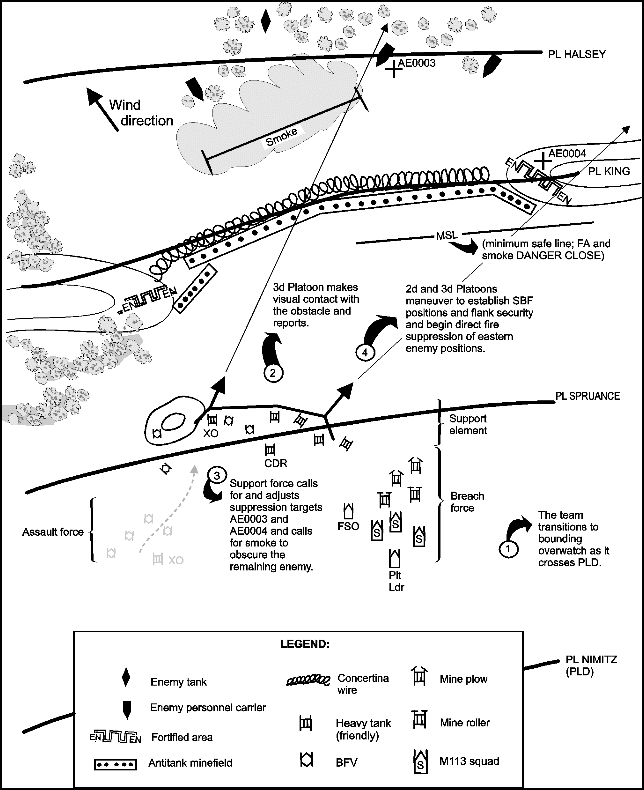 |
Figure 5-9. Company team sets the conditions for the breach.
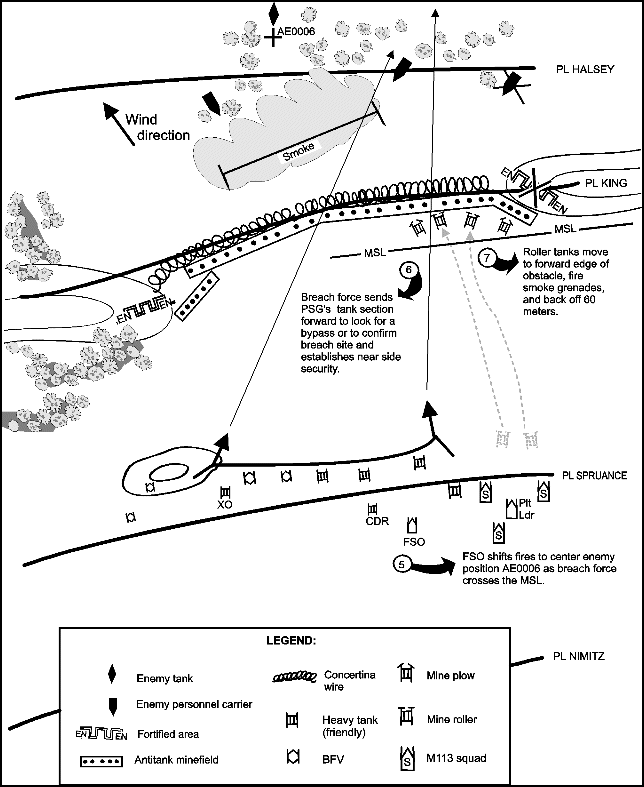 |
Figure 5-10. Company team establishes security.
Figure 5-11. Company team conducts the breach.
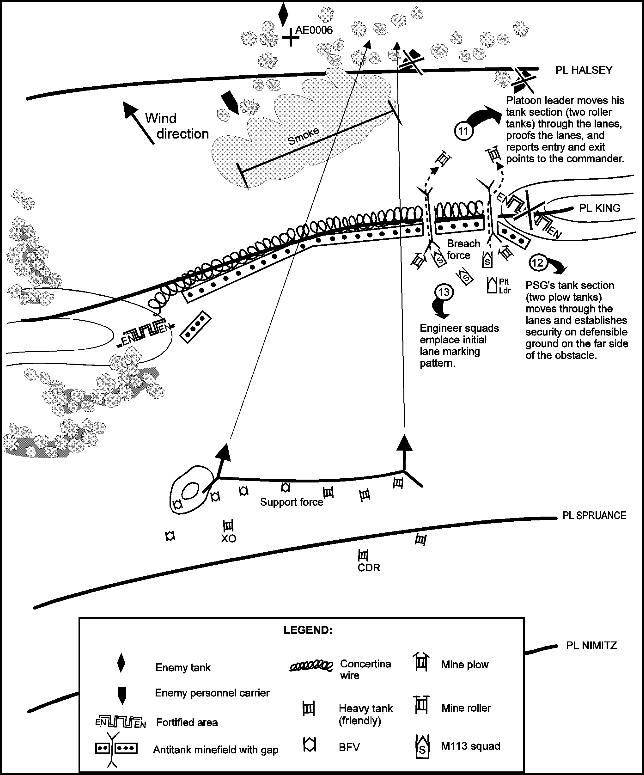 |
Figure 5-12. Breach force proofs the lanes and establishes far side security.
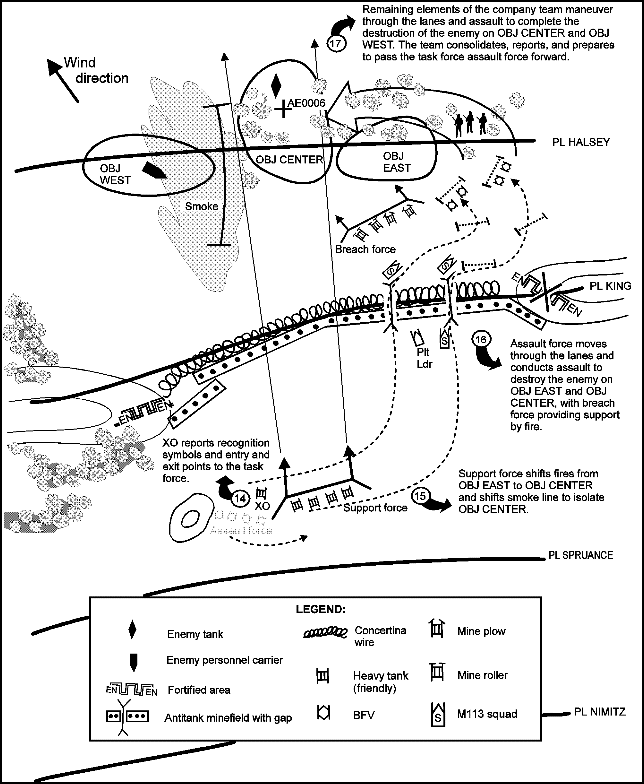 |
Figure 5-13. Assault force conducts the assault and secures the objective.
SECTION 7 - HASTY WATER CROSSING AND GAP CROSSING OPERATIONS |
|||
The company team may take part in three types of water crossing operations: hasty, deliberate, and retrograde. It normally participates in a hasty water crossing as part of a task force and in deliberate or retrograde crossings as part of a brigade or larger element. The team may also conduct a hasty gap crossing independently when supported by attached engineer assets. |
|||
|
Hasty water crossings are decentralized operations to cross inland bodies of water such as canals, lakes, or rivers. These operations include crossing by tactical bridging or by vehicle swimming or fording operations. (NOTE: For a detailed explanation of deliberate and retrograde water crossings, refer to FM 90-13.) The task force commander (or company team commander, if applicable) may choose to conduct a hasty crossing when the momentum of the operation must be maintained, when the banks are lightly held or undefended, and when sufficient CS assets are available to support the crossing. Despite the use of the term "hasty," the commander must use all available time and assets to ensure that the conditions are set for the crossing. The crossing is similar to a breach in that suppression and obscuration normally precede any attempt to cross the obstruction. |
|||
|
The company teamís organic water crossing capabilities include the M113ís ability to "swim" and the fording capability of M1-series tanks. The team may also have an AVLB or Wolverine attached for hasty water crossing. Other engineer assets for water crossing operations are covered in more detail in FM 90-13. |
|||
Amphibious vehicles |
Amphibious vehicles like the M113 series should cross bodies of water in groups, preferably by platoons. If there is no current, each group should cross in line formation. An echelon formation should be used to compensate when there is a current. Amphibious vehicles should cross downstream from tank fording sites. In preparing for crossing operations, commanders must take into account the time required to prepare the vehicles for swimming. |
||
Fording vehicles |
Without special preparation, tanks can ford water obstacles up to 4 feet deep if the stream bed has a solid bottom and the banks have been prepared. (NOTE: If tactically feasible, bridges from the AVLB or Wolverine can be used to solidify the bottom of ford sites.) Ford sites should be proofed for obstacles before the crossing begins. |
||
Vehicle launched |
Units equipped with the AVLB can lay an 18-meter (60-foot) bridge, supporting MLC 60 vehicles, in about four minutes. The bridge can span unprepared gaps of up to 17 meters (57 feet). Units equipped with the Wolverine bridge vehicle can span a gap of more than 24 meters (75 feet) and cross vehicles up to MLC 70. |
||
The task force commander organizes his units into assault, support, and follow and support forces. The company team must be prepared to execute any of these missions as part of a task force water crossing mission. |
|||
Assault force |
Transported by assault boats or air assault aircraft, this element conducts the initial assault across the body of water. It normally seizes immediate objectives on the far side to secure the crossing site for other task force elements. If it has the capability, the assault force then continues the advance from the exit bank to the final objective. Infantry elements establish local security on the exit bank to permit development of the crossing site. Engineers move with the assault force to breach obstacles and open or improve trails. |
||
Support force |
The support force normally consists of engineer elements and command and control elements from the controlling headquarters. It develops the crossing site, emplaces the crossing means (if applicable), and controls units moving into and away from the crossing site. The controlling commander may also position the support force where it can assist the assault force in the direct assault on the crossing site. The engineers provide these types of support for crossing operations:
|
||
Follow and |
The follow and support forceís primary mission is to provide protection as the assault force moves to the far side of the water obstacle and seizes its immediate objectives. The follow and support force does this mainly by suppressing defending enemy elements with both direct and indirect fires and by firing or calling for smoke to screen the crossing site from enemy observation. It must also be prepared to take over the assault forceís mission. |
||
In most circumstances, these operations are limited to "dry" gaps such as irrigation ditches, railroad embankments, and antitank ditches. Operational considerations for a company team hasty gap crossing are similar to those for a breach, with the team task organized into support, breach, and assault forces. (NOTE: For a description of each elementís responsibilities, refer to the discussion of breaching in Section 6 of this chapter.) The primary crossing means in the company team hasty gap crossing is the AVLB or Wolverine, which moves as part of the breach force. Without a vehicle launched bridge, the team may employ a field expedient method, such as the use of explosives, to facilitate the crossing. |
|||